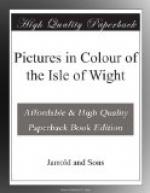TENNYSON’S AVENUE, FRESHWATER.—Leading from the main road, near Stark’s Hotel, is a lane giving access to the Downs and leading to the Avenue, across which is a small wooden bridge connecting Lord Tennyson’s grounds. A quiet, secluded spot yet visited by crowds of admirers of the late Laureate. Tennyson loved retirement, and in scenes like these, surrounded with the loveliness of Nature, the breathings of his genius found full and free expression. The lane may be pursued under the bridge past the farm into the Alum Bay Road.
[Illustration: Freshwater Bay.]
FRESHWATER BAY.—To those who desire to escape from the noise and traffic of the city, Freshwater Bay affords a delightful retreat. During the bright days of summer the sea breaks in gentle murmur on the sand and shingle of the beach, but in winter when lashed by S.W. Gales “it tumbles a billow on chalk and sand.” The roar of the ocean can be heard for miles inland. The esplanade shown in the picture has been destroyed by the breakers. Temporary repairs have been effected, but a fierce controversy is still raging as to the ultimate solution of the question, how to prevent further encroachment, and the L.G.B. has been appealed to for help.
[Illustration: Farringford, Freshwater, Lord Tennyson’s Residence.]
FARRINGFORD, FRESHWATER, LORD TENNYSON’S RESIDENCE.—The residence of the late Laureate is in the neighbourhood between freshwater Gate and Alum Bay, secluded by trees almost to invisibility. The front is covered with greenery, a fine magnolia growing round and over the front door. From under the lateral branches of a fine spreading cedar tree the Poet could look into Freshwater Bay and yet himself not be seen. The park-like grounds are pleasant to walk in, and are open to the inspection of visitors on Thursdays at certain seasons. In his poem of invitation to Rev. F. D. Maurice in 1854 he well describes it:
“Where far from smoke and noise
of town,
I watch the twilight falling brown,
All round a careless order’d
garden,
Close to the ridge of a noble down.”
[Illustration: Godshill Church.]
GODSHILL CHURCH.—Built in a striking and conspicuous situation, Godshill Church is visible from many distant points of the surrounding country—a good example of Early Perpendicular architecture, a cruciform structure having two equal aisles of its whole length, with a fine pinnacled tower and sancte-bell turret in the south transept gable. The tower has been recently rebuilt, having been shattered in a thunderstorm in January, 1904, when the clock face was torn out and thrown out into the churchyard. It contains monuments to the Worsley family and the tomb of Sir John Leigh; also a fine painting, of the school of Rubens, of Daniel in the Lions’ Den. There are tea-gardens in the village for the accommodation of the numerous visitors who throng there from Shanklin, Sandown, and other places in the vicinity. There is also the old village inn, the Griffon.




